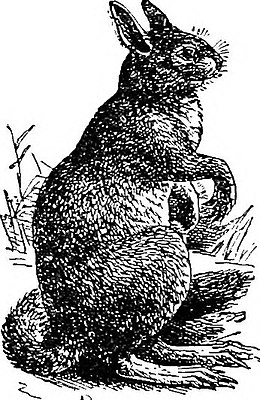Yarkand rabbit
| Yarkand rabbit | ||||||||||||
|---|---|---|---|---|---|---|---|---|---|---|---|---|

Yarkand hare ( Lepus yarkandensis ) |
||||||||||||
| Systematics | ||||||||||||
|
||||||||||||
| Scientific name | ||||||||||||
| Lepus yarkandensis | ||||||||||||
| Günther , 1875 |
The Yarkand hare ( Lepus yarkandensis ) is a species of mammal belonging to the genus of the real hare within the hare-like species . He's in the Tarim Basin of the northwest of the People's Republic of China located Autonomous Region Xinjiang endemic .
features
The Yarkand hare is a small type of rabbit with a body length between 28.5 to 43 centimeters and a weight of 1.1 to 1.9 kilograms. The head, the body and also the top of the tail are monochrome sand-colored with a pink tinge in summer. The sides of the body are yellowish-sand colored and the belly side is white. Unlike other hare species, it has no black hairs on its tail. The long ears also have no black tip. The greatest similarity is with the Kaphasen ( Lepus capensis ).
distribution
The distribution area of the Yarkand hare is limited to the Tarim basin of the Chinese Xinjiang . The area of the species forms a ring around the Taklamakan desert, as the animals depend on the vegetation and thus the humidity of the rivers coming from the mountains.
The preferred habitat are poplar forests , tamarisk stands and shrubby shrubbery along the rivers, he avoids agricultural areas.
Way of life
The Yarkand hare is mostly nocturnal with the main activity in the early morning and after sunset, but it can also be observed during the day. It feeds mainly on grasses and herbs, but also on crops and can therefore cause local damage to melon plantations . He creates shallow hollows in the vegetation under bushes. Several individuals can be observed at the same time at water points.
Little data is available on reproduction. The mating season probably extends from February to September. There are two to three litters per year, the litters include two and five young animals.
Systematics
The Yarkand hare is assigned to the real hare (genus Lepus ) as an independent species . Subspecies are not described.
Hazard and protection
The Yarkand hare is mainly hunted for its fur and meat. Between 1958 and 1981 around 10,000 animals were shot and pelts produced each year. Although the hare is not uncommon in the region, it is assumed that the population has declined moderately by around 30% in recent years, mainly due to the change in habitat due to increasing agricultural use. The gene flow between the individual populations is now low due to the increasing isolation on island habitats.
The species is classified by the International Union for Conservation of Nature and Natural Resources (IUCN) as a type of the warning list ("near threatened") due to its relatively large distribution area. However, concrete data on the development of the population are not available.
literature
- Joseph A. Chapman, John EC Flux (Eds.): Rabbits, Hares and Pikas. Status Survey and Conservation Action Plan. (PDF; 11.3 MB) International Union for Conservation of Nature and Natural Resources (IUCN), Gland 1990. ISBN 2-8317-0019-1 .
Web links
- Lepus yarkandensis in the endangered Red List species the IUCN 2011. Posted by: AT Smith, CH Johnston, 2008. Accessed January 25, 2012 Design.
Individual evidence
- ↑ a b c d Joseph A. Chapman, John EC Flux (Ed.): Rabbits, Hares and Pikas. Status Survey and Conservation Action Plan. (PDF; 11.3 MB) International Union for Conservation of Nature and Natural Resources (IUCN), Gland 1990. ISBN 2-8317-0019-1 .
- ↑ a b c d Lepus yarkandensis in the endangered Red List species the IUCN 2011. Posted by: AT Smith, CH Johnston, 2008. Accessed January 25, 2012 Design.
